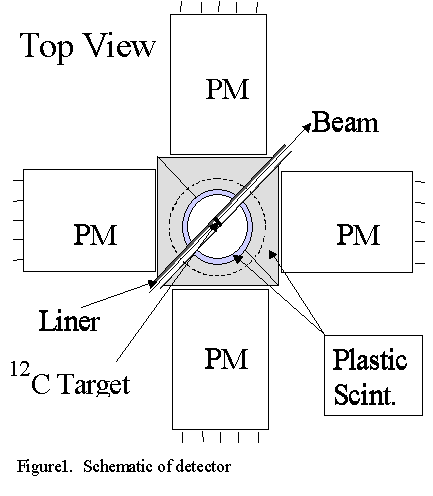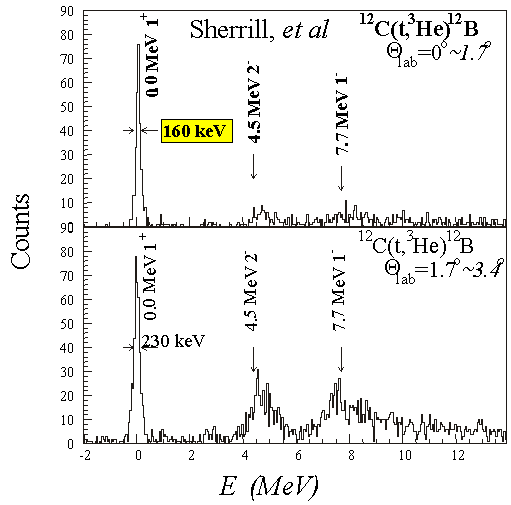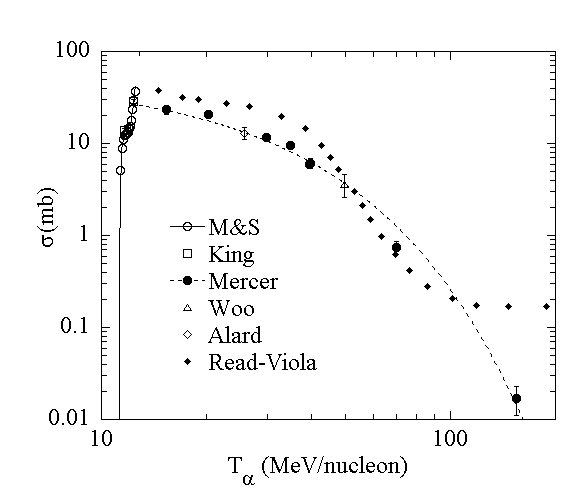
Making Carbon in Stars: (Falk Herwig, LANL, Sam Austin MSU)
An important fraction of carbon in the cosmos is produced by Asymptotic Giant Branch (AGB) stars. These stars have exhausted first the hydrogen and then the helium in their cores and are burning hydrogen and helium in shells surrounding the carbon + oxygen core. During a late phase of their evolution these stars undergo instabilities in the helium burning shell and undergo violent pulse which both produce carbon and later bring it to the stellar envelope. This envelop is convective so the carbon produced is transported to the surface of the star where strong stellar winds blow it into the interstellar medium. A mystery, the carbon star mystery, is that light, 1-2 solar mass stars, are observed to have carbon rich surfaces but simulations fail to produce carbon rich envelopes. We have investigated whether uncertainties in the reaction rates could result in greater carbon production. We find that varying either the 14N(p,gamma) or the triple alpha reaction rates to their lower or upper limits respectively, could explain the observed carbon abundance.


Helium Burning In Stars: (MSU:Sam Austin, Ken Yoneda, Chris Starosta; WMU (Alan Wuosmaa)).
Although the triple-alpha reaction plays a central role in
the production of 12C in stars, it is only recently that the range of
its effects and the required precision of its reaction rate has become clear.
The best known example is in SNII explosions, where a precision in the
ratio of the triple-alpha and 12C(a,g)
rates is required to reproduce the abundances of medium mass elements [1]. It
has also been shown that the production of 12C in Asymptotic Giant
Branch stars varies by a factor of two or more if one changes the triple-alpha
rate within its uncertainty range [2]. The
reaction is also important in understanding the early evolution of the first
(initially zero metallicity) stars.
Recent measurements [3] have shown that the rate of the triple-alpha reaction
over a wide range of temperatures, from 107 to 1010 K,
is well reproduced by the contributions
of the Hoyle state, the 0+ state at 7.65 MeV in 12C.
Improving the accuracy of the rate then depends essentially on improving
our knowledge of the 0+ state, and in particular its radiative width
Grad. Presently
Grad is known to about 13% which dominates the triple-alpha
uncertainty; the position of the
resonance is sufficiently well known. Grad
is determined from:

A Western Michigan University--Michigan State University
collaboration is undertaking a new measurement of the pair branch that is
expected to reduce its uncertainty to about 5%.
The principle is simple—see Fig. 1.
The 7.65 MeV state is excited by inelastic proton scattering, taking
advantage of a strong resonance at an excitation energy of 10.6 MeV and 135
degrees in the lab. The proton beam is provided by the newly refurbished EN
Tandem Accelerator at Western Michigan University. The pair branch is given
essentially by the ratio of the number of positron-electron pairs detected in
the plastic scintillators to the number of scattered protons from the 7.65 MeV
state. In order to reduce the gamma
ray background a coincidence is required between a thin cylindrical scintillator
and a large plastic scintillator surrounding it.
This will little affect the number of detected pairs, but will strongly
discriminate against gamma rays, which have small probability of interacting in
the thin scintillator. An
investigation of the systematic uncertainties in an earlier experiment [5]
indicates that an accuracy of ±5%
is achievable.
The present state of the experiment is as follows:
A GEANT simulation of the detector has been carried out to fix the
detector design parameters, a detailed design is out for bid, photomultipliers
and silicon detectors have been obtained, and the scattering chamber has been
expanded and cleaned to reduce contaminant background.
First data should be taken late in summer, 2005
References
[1] S. E. Woosley, A. Heger, T. Rauscher, and R. D. Hoffman, Nucl. Phys. A 718, c3 (2003).
[2] F. Herwig and S. M. Austin, Astrophys. J. Lett, 613, L81 (1994). F. Herwig, S. M. Austin and J.C. Lattanzio, Phys Rev. C, submitted
[3] H. O. U. Fynbo, et al., Nature 433, 136 (2005).
[4] H. Crannell, et al., Nucl. Phys. A, to be published
[5] R. G. H. Robertson, R. A. Warner and S. M. Austin, Phys. Rev. C, 15 1072 (1977).

Electron Capture for stable nuclei via (t, 3He) reactions and Supernovae Evolution: ( With R. Zegers, B. Sherrill, NSCL A1200 Group, Osaka).
Electron capture (EC) on stable and radioactive elements governs the electron abundance in pre-supernova stars and hence the size of the collapsing core in Type II supernovae. It is also important in determining the distribution of iron-like elements produced in Type IA supernovae. We plan to study EC strength on stable nuclei using the (t, 3He) reaction. Secondary triton beams and the use of the S800 spectrograph in a dispersion matched mode should provide resolutions 5-10 times better than that obtained with (n,p) reactions at TRIUMF, permitting a much more detailed understanding of the EC strength. The experiments and the theoretical analysis both appear to be much simpler than for the (d, 2He) reaction studied at KVI. Preliminary results for12C and 58Ni obtained in collaboration with the Osaka group shoed great promise--see figure.
We have obtained an enhanced tritium yield (> 107/ sec) using the 16O + 9Be as a source reaction and have performed new measurements on 2H, 12C, 24,26Mg, 63Cu, and 94Mo to calibrate the reaction and to determine GT strength in the Fe region and in the Z , N > 40 region where shell closures strongly reduce GT strength in the naive Shell Model. Use of more realistic wave functions (Langanke, et al. PRL 90, 241102 (2003), shows that these heavier nuclei dominate electron capture and significantly affect supernova properties during the collapse phase. Unfortunately , there have been very few detailed studies to validate the approximations used in these model calculations. The present experiments are intended to remedy this situation and provide the tests of the calculations that are necessary to put the theoretical description on a firmer basis.
Eventually, we hope to build a high efficiency tritium ion source to make possible experiments with primary beams. The resulting resolution is expected to be well under 100 keV, and will permit rigorous tests of model calculations in the mass range near and above Fe.

Electron Capture on key radioactive nuclei using inverse kinematics reactions (with A. Cole. R. Zegers, B. Sherrill et al.). Radioactive nuclei play an important role in the evolution of a supernova's pre-collapse core. In order to develop techniques for studying these reactions in inverse kinematics, we have measured cross sections for the 7Li (56Ni, 56Co)7Be(gamma) reaction. The gamma ray labels the GT transitions leading to the first excited 1/2+ state of the 7Be ejectile . This reaction appears to have the most promise for studies in inverse kinematics. The data is under analysis.
Nucleosynthesis by Cosmic Rays in the Early Galaxy: (with D. Mercer).
Galactic evolution models indicate that a + a reactions play an important role in the synthesis of 6,7Li in the early galaxy; however, the cross sections leading to 6Li are poorly known, making it difficult to check the models. As more data on the 6Li abundance in very metal poor stars become available, this has become an important problem, because 6Li can be used to limit also the astration of 7Li in these stars. The energies needed for these measurements are uniquely available at the NSCL. We developed a new technique which made the measurements possible and have obtained sufficiently accurate date up to a bombarding energy of 150 MeV/nucleon. In the graph the total cross section for production of 6Li is shown as a function of the bombarding energy. The small points show the standard cross sections (Read and Viola) previously used for cosmic ray studies, and the larger points are from the present measurements at the higher energies and from a re-analysis of earlier data at the lower energies. The dashed curve is an exponential fit to the data. These results allow a much better founded prediction of the production of 6,7Li by cosmic ray alpha + alpha collisions in the early galaxy. The resulting 6Li production, calculated for a typical cosmic ray spectrum, is about a factor of two smaller than for the Read-Viola cross sections normally used. In many models the calculated production of 6Li is at most that observed, greatly limiting possible astration of 6Li.
